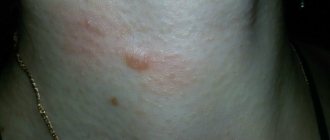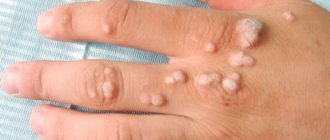What consequences can occur after mole removal?
What to do
if the removed mole starts to grow again?
These and other questions about the recurrence of nevi are answered by a specialist - Sergey Aleksandrovich Tverezovsky, oncologist surgeon, candidate of medical sciences, mammologist, oncodermatologist, doctor of the highest category.
When removing moles or other skin growths, the doctor always explains to the patient the preferred method of removal and its feasibility.
Excision of a mole with a scalpel along with a flap of skin is used extremely rarely - if the nevus has a large base area (exceeds 2.5 cm) or if there is relative doubt about its benignity. In the remaining 90-95% of cases of mole removal, the oncodermatologist uses laser or radio wave methods, or a combination of both.
What problems might the patient encounter?
What determines the risk of scarring?
The appearance of a scar and its nature depends on a number of factors:
- Depth and area of damage: if they are small, a scar may not appear at all.
- Tissue healing abilities.
- The presence of chronic diseases (for example, diabetes).
- Time for complete healing of the wound (it may increase if the wound has become infected).
The process of complete wound healing, which lasts for 21 days, ends with pathological scarring in only 33% of cases. If the process lasts more than 21 days, the probability increases to 78%.
How does a wound heal?
The following phases of wound healing are distinguished:
- Inflammation. It begins immediately after the injury and lasts about 2-3 days, during this phase it is necessary to clean the wound and carry out anti-infective measures.
- Proliferation. From 3 days to 2 weeks. It is necessary to maintain the absence of infection and adequate hydration.
- The appearance of a scar. From 2 weeks to several years. During this phase, measures are taken to correct the scar depending on its type. [12]
Removal and treatment of moles with laser
After laser removal of a mole and to achieve the best cosmetic result until the wound heals, it is recommended to follow these recommendations:
- Avoid UV rays (and when unavoidable, use sunscreen with at least SPF 30, preferably SPF50). If the patient tans during healing, there is a high likelihood of post-inflammatory pigmentation, which can make the area where the procedure was performed more visible;
- Do not go to solariums, saunas, swimming pools, or engage in vigorous physical exercise (to avoid infections and injuries).
- As the wound heals, dry scabs form and act as a natural dressing to prevent infection. These scabs should not be scratched or otherwise torn off - wait until they fall off on their own.
During the procedures prescribed by the doctor - disinfection and dressing - the wound heals well and no infectious (or other complications) arise. Once the wound has healed, redness persists and sometimes it takes 1 to 2 months for the area of skin to reach its final appearance after the procedure. If the initial scabs have fallen off and there is an increased risk of scarring, a special scar treatment cream can be applied.
The main measures that are recommended for the treatment of scars formed after laser mole removal are as follows:
- Special purpose creams with silicone and so on.
- Special patches with silicone.
Silicone patch for scar treatment
Is a scar a reason to go to the doctor?
Reasons for visiting a doctor:
- aesthetic dissatisfaction;
- itching and pain in the scar area;
- the formation of deformities and contractures, which can lead to disability.
If scar tissue begins to develop pathologically and causes a keloid scar, it is better to consult a doctor.
There are factors that increase the risk of developing a scar:
- genetic predisposition;
- race (black patients are more likely to develop keloids);
- localization of injury (when removing tumors in the chest, neck and shoulders, the likelihood of keloid scars is higher);
- age (the formation of keloid scars is typical for young people)
Laser removal of tumors. Possible complications after the procedure
After surgery, you need to carefully monitor the operated area of skin.
Because after surgery, symptoms may appear that require immediate medical attention or additional treatment.
Symptoms:
- Itching, excessive wetting of the wound.
- Bleeding from the wound.
- Heat.
- Pus is released.
- Skin inflammation lasting several days.
Laser removal of tumors. Consequences
It happens that the healing process has slight deviations from the norm, but they can be eliminated with additional treatment.
Let's consider the possible consequences:
- Small blisters on the area of skin where surgery was performed. Occurs when exposed to particularly sensitive skin. Over time, the blisters are replaced by barely noticeable scars.
- The occurrence of hypopigmentation - a light spot forms at the site where the neoplasm was located. Such a defect is a consequence if the removal of the tumor somehow affected the deep layers of the skin and if the rule of prohibiting visiting a solarium and prolonged exposure to the sun is neglected. The white spot will disappear on its own within two years.
- Recurrence of nevus (moles/papillomas). This situation is possible if laser removal of a tumor is performed by an inexperienced specialist and the papilloma/mole is not completely removed. Do not be afraid, this case does not cause harm to health. If the tumor reappears, it can be removed again.
- If the patient has diseases such as herpes and acne, then activation of inflammatory processes is possible.
- The appearance of a depression at the site where the removal was carried out. The situation arises due to the low rate of tissue restoration. The scar is barely noticeable and does not require intervention, since it smoothes out on its own over time.
- The appearance of a bulge at the site where the removal was performed, darker in color than the skin at the site. If this phenomenon does not smooth out within six months, then you need to consult your doctor.
How to prevent the appearance of a keloid scar?
There are several ways to prevent the appearance of a keloid scar.
- If surgical excision of the tumor is performed, techniques that minimize tension on the wound edges should be used during suturing.
- Mechanical stabilization - the use of special silicone plates or the use of silicone-based gels.
- The use of various medications containing flavonoids - substances obtained naturally from various plants (for example, onion extract). However, data on the effectiveness of this group of drugs is contradictory.
- Pressure therapy (compression) – within 15–40 mm Hg. Art. for 23 hours a day for 6 months. Data on the effectiveness of this method are also conflicting.
- Glucocorticosteroids (GCS) - can be used as creams or ointments in the initial stages of scar formation and to prevent its formation, as well as in the form of injections into scar tissue. [4]
How is mole histology performed?
Thanks to histological examination, cancer cells can be detected even at the stage of their inception.
Indications for mole histology:
- redness of the skin around the tumor;
- small ulcers on the surface of the nevus;
- burning or pain in the mole area;
- change in color, size, shape of the tumor.
Histology is performed with the procedure of surgical excision of the mole. A small tissue sample is removed and sent for further examination. In the laboratory, biological material is placed in a special suspension and examined under a microscope. Diagnosis is based on the analysis of pigment-forming cells - melanocytes. Laboratory testing may take up to 14 days.
What if a scar appears?
Once scar tissue has formed, unfortunately, it will not be possible to completely get rid of it. All medical actions in this case will be aimed at minimizing the manifestations of the scar. The following methods are used to treat formed keloids:
- GCS injections are a popular and effective method for treating keloid and hypertrophic scars. A GCS solution is injected into the scar tissue 1–2 times a month until the expected results appear. Unfortunately, with excessive use of the drug, skin atrophy may develop at the injection site, telangiectasia or an atrophic scar may appear. [4]
- Surgical excision of the scar - you should not resort to this method as the only remedy, since it always ends in a relapse that exceeds the existing scar in area. This method can be resorted to after previous long-term therapy carried out in various ways. [4]
- Cryotherapy is the treatment of scars with liquid nitrogen. There are various methods of its use: spray, contact method and intralesional cryoprobe. The latter method is more effective. In addition, the combination of cryotherapy with GCS injections gives the best result compared to others. [4]
- Laser treatment – various lasers are used. Nd:YAG laser with a wavelength of 1,064 nm is used to target the vessels of scar tissue. In addition, CO2 and Er:YAG lasers are actively used in fractional mode. But it is not recommended to use ablative lasers (CO2 and Er:YAG) as the only treatment method, since in this case there is a high probability of relapse. [5]
A dye laser (PDL) with a wavelength of 585 nm is also considered effective. [6]
There is evidence of the effective use of CO2 laser in fractional mode during surgery to improve the cosmetic outcome of healing. [7]
- Ointment with 5-fluorouracil for the treatment of scars, but it is not sold in Russia. [4]
- Botulinum toxin type A is used to weaken the tension of the wound edges by reducing muscle activity. Injections are given immediately after surgery. [8]
- Imiquimod cream is recommended for use after surgical excision of a scar to minimize the likelihood of recurrence. [9]
- Other methods - bleomycin, verapamil, TGF-β, interferon, tacrolimus, sirolimus, tamoxifen, epidermal growth factor, retinoic acid, tamoxifen and other drugs are also considered effective for the treatment of scars. [10]
Which method is the most effective?
Unfortunately, there is no most effective treatment for scars. The most effective is considered to be a combination of various methods, which is always selected individually. Injections of corticosteroids into hypertrophic or keloid scars are considered an accessible, effective and inexpensive method.
Atrophic scars are distinguished separately: for their correction, planar ablative lasers, fractional ablative lasers (CO2 and Er:YAG), various combinations of lasers (fractional +PDL, Qsw+fractional lasers), collagen, fillers with hyaluronic acid, PRP therapy, microneedling are used. , peeling and a number of other methods [11, 12]
Previously, the dermabrasion method was used to correct atrophic scars, but now it is practically not used, since it is associated with the risk of side effects: bacterial or viral complications, telangiectasia, hyperpigmentation, a long rehabilitation period, as well as hypertrophic or keloid scars.
How not to treat scars
Incorrect treatment, in addition to wasting money and time, can lead to enlargement of the scar. What could cause this:
- non-compliance with doctor’s recommendations after removal or self-medication;
- traumatization and irritation of the wound can lead to relapse;
- non-compliance with prescribed antiseptic methods;
- removal of the crust that has formed at the site of removal: under it the restoration process is more efficient.
There is not enough information in scientific sources to evaluate the effectiveness of folk remedies in the treatment of scars. From my experience I can say that I have not seen a single patient for whom folk remedies produced any significant positive changes. And in fairness, it’s worth saying that I rarely encounter the use of folk remedies in the treatment of scars.
Medical - advantages of ordering laser resurfacing
Our clinic uses advanced laser devices to quickly, effectively, painlessly eliminate scars after removing moles on the face. We provide professional consultations to patients, set reasonable prices for all types of minimally invasive treatments, use high-quality medications, and have extensive experience.
Make an appointment with us for a procedure for removing scars left from a nevus. Our experienced specialists will make your body beautiful by eliminating unwanted pigment spots. We are waiting for a call.
Bibliography:
- J Am Acad Dermatol. 2016 Apr; 74(4): 607–25; quiz 625–6. doi: 10.1016/j. jaad. 2015.08.070. Wound healing and treating wounds: Chronic wound care and management. Powers JG, Higham C, Broussard K, Phillips TJ.
- J Am Acad Dermatol. 2016 Apr; 74(4): 589–605; quiz 605–6. doi: 10.1016/j. jaad. 2015.08.068. Wound healing and treating wounds: Differential diagnosis and evaluation of chronic wounds. Morton LM, Phillips TJ.
- Ann Hum Genet. 2022 Feb 27. doi: 10.1111/ahg.12245. Gene-based evaluation of low-frequency variation and genetically-predicted gene expression impacting risk of keloid formation. Hellwege JN, Russell SB, Williams SM, Edwards TL, Velez Edwards DR.
- Int. J. Mol. Sci. 2022, 19(3), 711; doi: 10.3390/ijms19030711. Recent Understandings of Biology, Prophylaxis and Treatment Strategies for Hypertrophic Scars and Keloids. Ho Jun Lee, Yong Ju Jang.
- Br J Dermatol. 2011 Nov; 165(5): 934-42. doi: 10.1111/j.1365-2133.2011.10492.x. Laser and intense pulsed light therapy for the treatment of hypertrophic scars: a systematic review. Vrijman C, van Drooge AM, Limpens J, Bos JD, van der Veen JP, Spuls PI, Wolkerstorfer A.
- Laser Ther. 2013 Dec 30; 22(4): 255–260. doi: 10.5978/islsm.13-OR-20 Laser Scar Management Technique. Takafumi Ohshiro, Toshio Ohshiro, and Katsumi Sasaki
- Arch Dermatol. 2011 Sep;147(9):1108-10. doi: 10.1001/archdermatol.2011.248. A randomized split-scar study of intraoperative treatment of surgical wound edges to minimize scarring. Ozog DM, Moy RL.
- Plast Reconstr Surg. 2022 Mar;141(3):646-650. doi: 10.1097/PRS.0000000000004110. Effects of Botulinum Toxin on Improving Facial Surgical Scars: A Prospective, Split-Scar, Double-Blind, Randomized Controlled Trial. Hu L, Zou Y, Chang SJ, Qiu Y, Chen H, Gang M, Jin Y, Lin X.
- Curr Pharm Des. 2017;23(15):2268-2275. doi: 10.2174/1381612822666161025144434. The Effectiveness of Topical Anti-scarring Agents and a Novel Combined Process on Cutaneous Scar Management. Fang QQ, Chen CY, Zhang MX, Huang CL, Wang XW, Xu JH, Wu LH, Zhang LY, Tan WQ.
- Dermatol Surg. 2022 Jan; 43 Suppl 1:S3-S18. doi: 10.1097/DSS.0000000000000819. Keloids and Hypertrophic Scars: Pathophysiology, Classification, and Treatment. Berman B, Maderal A, Raphael B.
- Clinical and Experimental Dermatology, June 1, 2013. Combination of intense pulsed light and fractional CO2 laser treatments for patients with acne with inflammatory and scarring lesions. B. Wang, Y. Wu.
- Skinmed. 2022 Aug 1; 15(4):271-276. eCollection 2022. Techniques for Optimizing Surgical Scars, Part 1: Wound Healing and Depressed/Atrophic Scars. Konda S, Potter K, Ren VZ, Wang AL, Srinivasan A, Chilukuri S.











